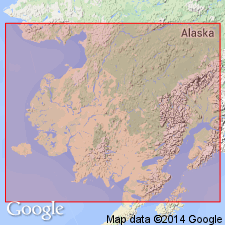
- Usage in publication:
-
- Terra Cotta series*
- Modifications:
-
- Named
- Dominant lithology:
-
- Limestone
- Slate
- Arkose
- AAPG geologic province:
-
- Alaska Southwestern region
Summary:
[Probably named for Terra Cotta Mountains, Alaska Range, southwestern AK.] All sedimentary rocks which lie to the west of Tordrillo series (new), where Kuskokwim River turns and runs to northwest, are named Terra Cotta series (new). Consists of heavy-bedded impure limestones, slates, and arkoses, and probably includes volcanic rocks. Is heavily folded and cut by intrusives. Conformably underlies Tordrillo series. Geologic sketch map legend shows age as Jurassic(?).
Source: GNU records (USGS DDS-6; Menlo GNULEX).

- Usage in publication:
-
- Terra Cotta series
- Modifications:
-
- Not used
- AAPG geologic province:
-
- Alaska Southwestern region
Summary:
Rocks of Terra Cotta series as defined by Spurr (1900) are equivalent in this report to Tatina group and Tonzona group (both new).
Source: GNU records (USGS DDS-6; Menlo GNULEX).
For more information, please contact Nancy Stamm, Geologic Names Committee Secretary.
Asterisk (*) indicates published by U.S. Geological Survey authors.
"No current usage" (†) implies that a name has been abandoned or has fallen into disuse. Former usage and, if known, replacement name given in parentheses ( ).
Slash (/) indicates name conflicts with nomenclatural guidelines (CSN, 1933; ACSN, 1961, 1970; NACSN, 1983, 2005, 2021). May be explained within brackets ([ ]).

